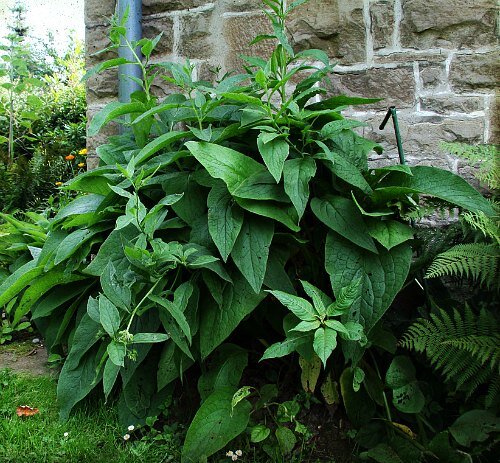
Dynamic Accumulators
Since the term was first introduced in the 1980s, the use of dynamic accumulators on the permaculture homestead has become a common practice. Across all climates and regions of the world, permaculture practitioners have been sharing their successes using a wide range of plants to accumulate specific nutrients in their foliage, which can then be harvested and used as mulch, compost, or home-brew liquid fertilisers. There are many lists to be found, in books and online, compiling the most popular dynamic accumulator plants and the nutrients they are thought to accumulate.
But there is one catch: practically everything we think we know about dynamic accumulators has so far been based on anecdotal evidence. As John Kitsteiner pointed out in his article “The facts about dynamic accumulators,” to date there has been virtually zero empirical research on the subject. This has led some people to the conclusion that dynamic accumulators are a myth. But those of us who see the glass as half-full would say that a wealth of anecdotal evidence supporting dynamic accumulators suggests there is something going on here, something that surely warrants investigation.
Defining Dynamic Accumulators
In response to this need, Northeast SARE (Sustainable Agriculture Research and Education, Northeast United States) provided a research grant to Unadilla Community Farm, in coordination with Cornell University, to help expand our collective understanding of what exactly dynamic accumulators are, how they work, and what are some practical applications for these plants. This article represents the first step in this research: defining what dynamic accumulators are.
Progress was recently made towards forming a definition in Dean Brown’s article “Qualifying dynamic accumulators: a sub-group of the hyperaccumulators,” where he points out the similarities between these two groups of plants. While dynamic accumulators are used to gather beneficial nutrients from the soil, hyperaccumulators are used to gather toxic heavy metals. When used for soil remediation, the plant tissue of hyperaccumulators is harvested and removed from the site. To qualify as a hyperaccumulator, a plant must accumulate metals above established threshold concentrations: 100ppm (for Cd), 1,000ppm (for Co, Cu, Ni, As, and Se), and 10,000ppm (for Zn and Mn). Brown suggests that similar thresholds should be set for dynamic accumulators, in ppm, using dried plant tissue samples, consistent with hyperaccumulator thresholds.
Helpful advice was also given recently by Robert Kourik, who was actually one of the first to popularise the concept of dynamic accumulators with his 1986 book, “Designing and maintaining your edible landscape – naturally.” In 2014, he revisited the subject with the article “Unstacking functions: dynamic accumulators,” suggesting that for a plant to qualify as a dynamic accumulator, we need “evidence of actual amounts (in ppm) of mineral/nutrient accumulation, as compared to other plants.” He then demonstrates how the USDA-hosted “Dr. Duke’s Phytochemical and Ethnobotanical Databases” can be used to compare nutrient values between thousands of plant species. Using these databases, we can establish average nutrient values across all plants and then set thresholds to identify the plants that possess comparatively high levels of specific nutrients in their foliage – the dynamic accumulators.
Building The List
Thanks to Brown and Kourik, we have been provided with clear instructions:
Analyse the USDA databases to determine nutrient value averages across all plant species we have data for. Following Brown’s advice, the “high ppm” values are used as these correspond with dried plant tissue samples, consistent with hyper-accumulator thresholds.
Set nutrient value thresholds for dynamic accumulators. Kourik suggested that dynamic accumulators should demonstrate high amounts of nutrient accumulation, as compared to other plants. To address this, we started by setting the thresholds at 200% of nutrient value averages, which results in about 10.40% of plants qualifying in each nutrient category. However, for this model to endure, the thresholds need to be fixed at specific values rather than remain relative to the averages, because those averages will change over time as new plants are added to the databases. So we rounded off the thresholds and set them at even numbers, still roughly 200% of the averages, representing the top 10.08% of plants.
And now for the exciting part: using these thresholds, which plants qualify as dynamic accumulators? We reviewed countless books and online articles to compile a list of all the plants reportedly used as dynamic accumulators, thanks to decades of informal research carried out by the permaculture community worldwide. And there is quite a bit of overlap between this list, and the list of plants from the USDA databases that meet the thresholds. To view the full list of dynamic accumulators scroll down.
Next Steps
The analysis carried out in this article is just the beginning. There are still so many unanswered questions surrounding dynamic accumulators! Do they really “mine” for nutrients deep underground, or are they simply robbing other plants of nutrients in the topsoil? Exactly how much “chopping and dropping” do I need for a measurable nutrient increase in my soil? And what exactly are the nutrient values for home-brew liquid fertilisers made from these plants?
These are some of the questions Unadilla Community Farm is now researching, as we closely study six plant species: comfrey, dandelion, lambsquarters, red clover, redroot amaranth, and stinging nettle. These species have been selected because they appear on both of the above lists: they are frequently mentioned as dynamic accumulators by the permaculture community, and they also meet the thresholds established using the USDA databases*. They also have a variety of root depths, growth habits, life cycles, and potential applications. And being cold-hardy perennials or self-seeding annuals (and often labeled “weeds” for their ability to flourish in adverse conditions), these six plants could easily be grown for use as dynamic accumulators across the Northeast United States, where this study takes place.